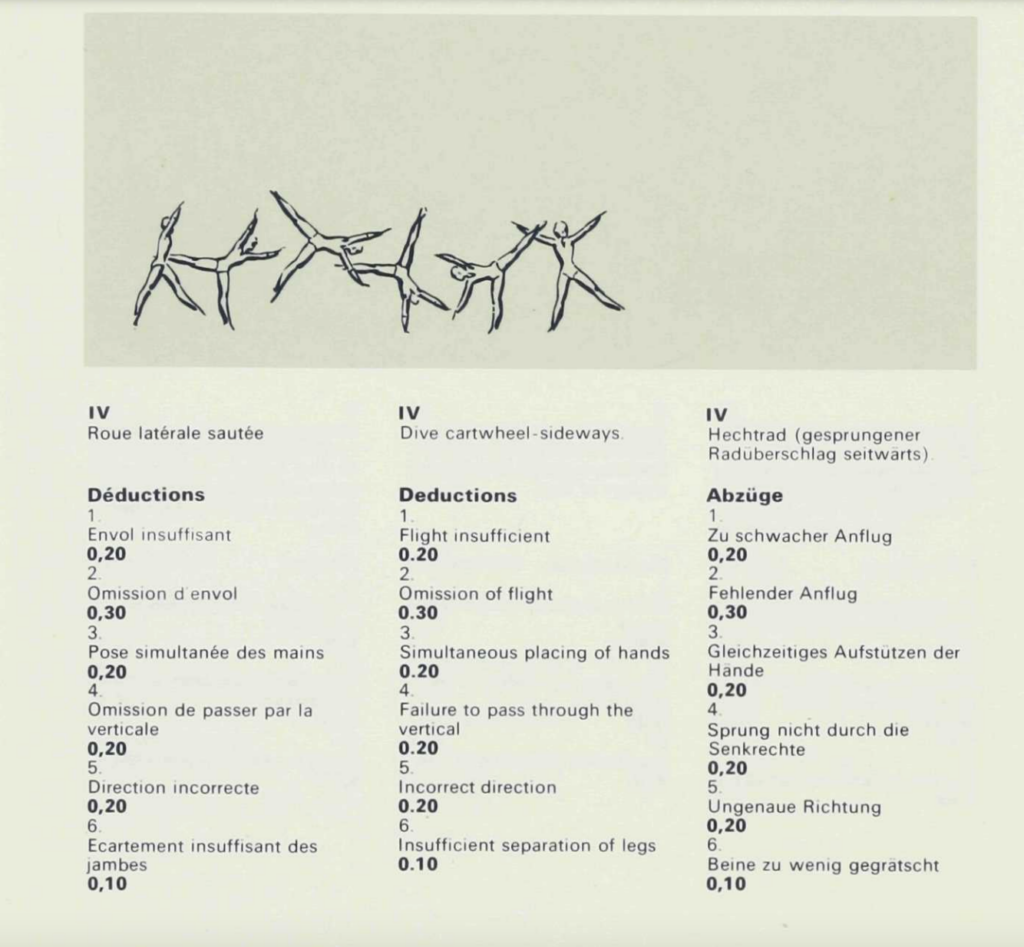Compulsory routines used to change every two years. There would be one set of routines for the World Championships, and then, two years later, there would be a new set of routines for the Olympic Games.
That changed in 1969. Though, the Men’s Technical Committee and Women’s Technical Committee took two divergent paths.

The Men’s Technical Committee’s Decision
In 1969, the Men’s Technical Committee chose to have one set of compulsory routines for four years. New routines were to be issued at the Olympic Games and would remain valid for the World Championships two years later.
Here’s how Olympische Turnkunst reported the news:
Glad News from FIG
At the FIG meeting on the occasion of the 5th Gymnaestrada in Basel a resolution was passed that will please gymnasts all over the world and make them thank the progressively-minded members of the FIG technikal [sic] committee: compulsory routines will from now on remain the same for 4 years! They will be issued for Olympic Games and be obligatory also for the following world championships. The advantage of this decision is not only that gymnasts have to spend less time and energy on compulsories but also that the time is long enough to reach real perfection that is the highest goal of gymnastics.
It is not known yet whether the same applies to FIG’s women. But it is sure Madame Villancher and her assistants adopt the innovation suggested by the USSR but also mooted in recent years by other Federations.
Olympische Turnkunst, September 1969
Bold text in the original text.
The Women’s Technical Committee’s Decision
The Women’s Technical Committee (WTC) chose a very different path for compulsories. They believed that four years were too long.
Madame Villancher stated that the FIG Technical Committee feels that four years is too long a time period for compulsory exercises to exist since the sport is developing so quickly.
Madamoiselle Gymnast, Jan/Feb 1971
Rather than have one set routine for four years, the WTC chose to give the gymnasts more freedom. Starting with the 1972 Olympics, they gave gymnasts specific skills that they had to perform in a specific order. But the connections between the skills were up to each team.
Here’s how the WTC described the connections between the elements:
Linkages
Uneven BarsOnly connections that are non-acrobatic in nature are allowed between the set elements
Floor and Beam
The following can be used as linkages: elements from modern gymnastics [i.e. rhythmic gymnastics], turns, pivots, hops, dance steps, balances, movements of flexibility
Excluded are all acrobatic elements such as round-offs, cartwheels, flic-flacs, handsprings, headsprings, saltos, leaps, split leaps, handstands, as well as all elements of suppleness, walkovers etc.
1972 Munich, Regulations, Gymnastics
The rules added:
No other element of difficulty may be added to those officially prescribed.
1972 Munich, Regulations, Gymnastics
To see the skills and the order in which they had to be performed, check out the following pages from the 1972 rulebook.
These skills were valid for…
4 years with the possibility of changing the order of the elements of difficulty on the uneven bars, beam, and floor after two years.
1972 Munich, Regulations, Gymnastics
Trying to imagine what this looked like?
You can see Cathy Rigby’s compulsory routines from 1972 here:
Different Interpretations
How many and how difficult should the linkages between the required elements be? That question was on the minds of head coaches in 1972.
After the Canadian team competed against the Soviet and West German teams, they realized that their compulsory routines were far more difficult than their European opponents:
Their compulsory execution was weak as a team and this surprised me, since compulsories at the international level should be flawless. However, the Canadian coaches discussed this with concern, and it was realized that the Russians and West Germans simply do not have the packed and intricate composition that we have chosen to use in between the FIG elements. The risk and difficulty portrayed by other teams is minimal. Our compulsory beam and floor routines were in comparison, long exercises with far more movement and unnecessary risk. However, in Europe, our routines were of high spectating interest because of the impressive composition. The girls have yet to assume the expertise and dance style of choreographer, Rolande.
Gymnast, April 1972
Note: Modern Gymnast changed its title to Gymnast in 1972.
Reverting Back…
Kudos to the WTC for trying something new, but, as one can imagine, this format for compulsories didn’t stick.
At the 1973 FIG Congress in Rotterdam, the Women’s Technical Committee decided to return to the old way of doing things. For the 1976 Olympics, they decided to abandon the more open-ended compulsories and create set routines:
VI II. New Compulsory Exercises for 1976 Olympic Games
A. The [Technical Committee] voted in favor of accepting the old compulsory format of set exercises for the Olympic Games.
B. The TC will compose these exercises and send them to the Federations in June 1974 for use in the Olympic Games. The film will be sent as soon as possible after the exercises.
USGF News, Dec. 1973